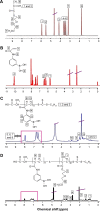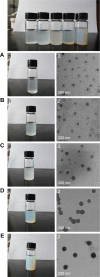Glucose- and temperature-sensitive nanoparticles for insulin delivery
- PMID: 28603417
- PMCID: PMC5457184
- DOI: 10.2147/IJN.S132984
Glucose- and temperature-sensitive nanoparticles for insulin delivery
Abstract
Glucose- and temperature-sensitive polymers of a phenylboronic acid derivative and diethylene glycol dimethacrylate (poly(3-acrylamidophenyl boronic acid-b-diethylene glycol methyl ether methacrylate); p(AAPBA-b-DEGMA)) were prepared by reversible addition-fragmentation chain transfer polymerization. Successful polymerization was evidenced by 1H nuclear magnetic resonance and infrared spectroscopy, and the polymers were further explored in terms of their glass transition temperatures and by gel permeation chromatography (GPC). The materials were found to be temperature sensitive, with lower critical solution temperatures in the region of 12°C-47°C depending on the monomer ratio used for reaction. The polymers could be self-assembled into nanoparticles (NPs), and the zeta potential and size of these particles were determined as a function of temperature and glucose concentration. Subsequently, the optimum NP formulation was loaded with insulin, and the drug release was studied. We found that insulin was easily encapsulated into the p(AAPBA-b-DEGMA) NPs, with a loading capacity of ~15% and encapsulation efficiency of ~70%. Insulin release could be regulated by changes in temperature and glucose concentration. Furthermore, the NPs were non-toxic both in vitro and in vivo. Finally, the efficacy of the formulations at managing blood glucose levels in a murine hyperglycemic diabetes model was studied. The insulin-loaded NPs could reduce blood glucose levels over an extended period of 48 h. Since they are both temperature and glucose sensitive and offer a sustained-release profile, these systems may comprise potent new formulations for insulin delivery.
Keywords: 3-acrylamidophenylboronic acid; diethylene glycol methyl ether methacrylate; glucose sensitive; insulin delivery; nanoparticle; thermosensitive.
Conflict of interest statement
Disclosure The authors report no conflicts of interest in this work.
Figures











Similar articles
-
Glucose-Sensitive Nanoparticles Based On Poly(3-Acrylamidophenylboronic Acid-Block-N-Vinylcaprolactam) For Insulin Delivery.Int J Nanomedicine. 2019 Oct 4;14:8059-8072. doi: 10.2147/IJN.S220936. eCollection 2019. Int J Nanomedicine. 2019. PMID: 31632018 Free PMC article.
-
Synthesis and evaluation of temperature- and glucose-sensitive nanoparticles based on phenylboronic acid and N-vinylcaprolactam for insulin delivery.Mater Sci Eng C Mater Biol Appl. 2016 Dec 1;69:1026-35. doi: 10.1016/j.msec.2016.07.078. Epub 2016 Aug 2. Mater Sci Eng C Mater Biol Appl. 2016. PMID: 27612799
-
Nanoparticles prepared from pterostilbene reduce blood glucose and improve diabetes complications.J Nanobiotechnology. 2021 Jun 27;19(1):191. doi: 10.1186/s12951-021-00928-y. J Nanobiotechnology. 2021. PMID: 34176494 Free PMC article.
-
Polymer-based nanoparticles for oral insulin delivery: Revisited approaches.Biotechnol Adv. 2015 Nov 1;33(6 Pt 3):1342-54. doi: 10.1016/j.biotechadv.2015.02.010. Epub 2015 Feb 26. Biotechnol Adv. 2015. PMID: 25728065 Review.
-
Recent Advances in Phenylboronic Acid-Based Gels with Potential for Self-Regulated Drug Delivery.Molecules. 2019 Mar 19;24(6):1089. doi: 10.3390/molecules24061089. Molecules. 2019. PMID: 30893913 Free PMC article. Review.
Cited by
-
Can nanoparticles and nano‒protein interactions bring a bright future for insulin delivery?Acta Pharm Sin B. 2021 Mar;11(3):651-667. doi: 10.1016/j.apsb.2020.08.016. Epub 2020 Sep 3. Acta Pharm Sin B. 2021. PMID: 33777673 Free PMC article. Review.
-
Glucose-Sensitive Nanoparticles Based On Poly(3-Acrylamidophenylboronic Acid-Block-N-Vinylcaprolactam) For Insulin Delivery.Int J Nanomedicine. 2019 Oct 4;14:8059-8072. doi: 10.2147/IJN.S220936. eCollection 2019. Int J Nanomedicine. 2019. PMID: 31632018 Free PMC article.
-
Insulin-loaded PLGA microspheres for glucose-responsive release.Drug Deliv. 2017 Nov;24(1):1513-1525. doi: 10.1080/10717544.2017.1381200. Drug Deliv. 2017. PMID: 28975813 Free PMC article.
-
pH-Responsive Hexa-Histidine Metal Assembly (HmA) with Enhanced Biocatalytic Cascades as the Vehicle for Glucose-Mediated Long-Acting Insulin Delivery.Adv Sci (Weinh). 2023 Aug;10(23):e2301771. doi: 10.1002/advs.202301771. Epub 2023 Jun 2. Adv Sci (Weinh). 2023. PMID: 37269054 Free PMC article.
-
Synthesis of multi-responsive poly(NIPA-co-DMAEMA)-PBA hydrogel nanoparticles in aqueous solution for application as glucose-sensitive insulin-releasing nanoparticles.J Diabetes Metab Disord. 2024 Mar 27;23(1):1259-1270. doi: 10.1007/s40200-024-01421-7. eCollection 2024 Jun. J Diabetes Metab Disord. 2024. PMID: 38932860 Free PMC article.
References
-
- Hotamisligil GS. Inflammation and metabolic disorders. Nature. 2006;444(7121):860–867. - PubMed
MeSH terms
Substances
LinkOut - more resources
Full Text Sources
Other Literature Sources
Medical
Miscellaneous

